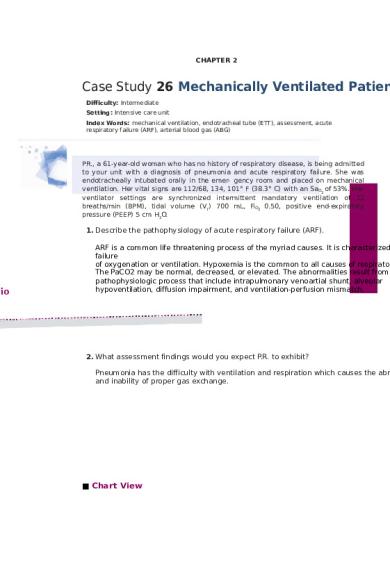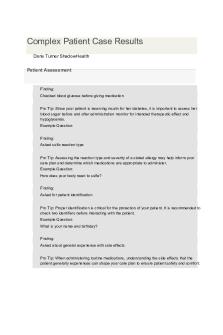Case Study Vent Patient student version PDF

| Title | Case Study Vent Patient student version |
|---|---|
| Author | Cherry Wong |
| Course | Advanced Practice Nursing |
| Institution | California State University San Marcos |
| Pages | 10 |
| File Size | 199.9 KB |
| File Type | |
| Total Downloads | 27 |
| Total Views | 196 |
Summary
case study for homework. Ventilation mechanical assignment...
Description
CHAPTER 2
Case Study 26 Mechanically Ventilated Patien Difficulty: Intermediate Setting: Intensive care unit Index Words: mechanical ventilation, endotracheal tube (ETT), assessment, acute respiratory failure (ARF), arterial blood gas (ABG)
PR., a 61-year-old woman who has no history of respiratory disease, is being admitted to your unit with a diagnosis of pneumonia and acute respiratory failure. She was endotracheally intubated orally in the emer- gency room and placed on mechanical ventilation. Her vital signs are 112/68, 134, 101° F (38.3° C) with an SaO2 of 53%. Her ventilator settings are synchronized intermittent mandatory ventilation of 12 breaths/min (BPM), tidal volume (VT) 700 mL, FiO2 0.50, positive end-expiratory pressure (PEEP) 5 cm H2O.
1. Describe the pathophysiology of acute respiratory failure (ARF).
rio
ARF is a common life threatening process of the myriad causes. It is characterized failure of oxygenation or ventilation. Hypoxemia is the common to all causes of respirator The PaCO2 may be normal, decreased, or elevated. The abnormalities result from t pathophysiologic process that include intrapulmonary venoartial shunt, alveolar hypoventilation, diffusion impairment, and ventilation-perfusion mismatch.
2. What assessment findings would you expect P.R. to exhibit? Pneumonia has the difficulty with ventilation and respiration which causes the abn and inability of proper gas exchange.
■ Chart View
PART 1 MEDICALSURGICAL
Copyright © 2013 by Mosby, an affiliate of Elsevier Inc. Copyright © 2009, 2005, 2001, 1996, by Mosby, Inc. an affiliate of Elsevier Inc. All rights reserved.
11
3. The arterial blood gas (ABG) results drawn in the emergency room before intubation are sent to you. Interpret P.R.'s ABG results.
Respiratory acidosis of the ph in acidosis value and PaCO2 increased
4. List eight interventions that would be implemented for P.R. and the rationale for ea
1. 2. 3. 4. 5. 6. 7. 8.
Administer and monitor oxygen Ensure adequate nutrition Encourage coughing and deep breathing Suction (pneumonia) Heparin for DVTs PPI for acid reflux to avoid aspiration Sputum culture Blood culture
5. After the insertion of the endotracheal tube (ETT), how is correct placement verified? Chest x-ray
6. Describe each of P.R.'s ventilator settings and the rationale for the selection of each Synchronized intermittent mandatory ventilation of 12 per minute and tidal volume FiO2 50% and PEEP of 5 cm H2O. SIMV delivers set about of breaths per minute, bu still breathing on their own between breaths. The PEEP keeps lungs open prevent t from collapsing.
118
Copyright © 2013 by Mosby, an affiliate of Elsevier Inc. Copyright © 2009, 2005, 2001, 1996, by Mosby, Inc. an affiliate of Elsevier Inc. All rights reserved.
■ Chart View
7. ABGs are redrawn after P.R. is on mechanical ventilation for 1 hour. What ventilator changes do you anticipate, based on your interpretation of these values? (Select all that apply, and explain your rationale.) a. Increasing the PEEP to 10 cm b. Increasing the rate on the ventilator to 16 breaths/min c. Increasing the tidal volume to 850 mL d. Changing to continuous mandatory ventilation
8. Evaluate each of the following statements about caring for P.R. or a similar patient receiving mechanical ventilation with an ETT. Enter “T” for true or “F” for false. Discuss why the false statements are incorrect. f 1. Administer mandatory muscle-paralyzing agents to keep the patient from “fighting the vent.” t 2. Check ventilator settings at the beginning of each shift and then hourly. t 3. When suctioning the ETT, each pass should not exceed 15 seconds. t 4. Assign an experienced NAP to take vital signs every 2 to 4 hours. f 5. Perform a respiratory assessment once per shift. f 6. Empty excess water as it collects in the ventilation tubing back into the humidifier. f 7. Keep a resuscitation bag at the bedside. t 8. Monitor the cuff pressure of the ETT every 8 hours. f 9. Keep ventilator alarms silenced when in the room to maintain a quiet environment. t 10. Change the ventilator tubing every 12 hours.
119
2 Respiratory
9. You hear the high-pressure alarm sounding on the mechanical ventilator and see that P.R.'s Sao2 is 80%. What are the potential causes of this problem? Water in the tubing or patient is biting or patient is coughing or secretion in tubing
CASE STUDY PROGRESS As P.R.'s nurse, you are concerned about meeting her needs for fluids, nutrition, oral hygiene, and skin integrity.
10. Discuss five indicators that would help you assess fluid status. 1. Input and output 2. Daily weights 3. Oral mucosa 4. Skin turgor 5. electrolyte
11. What are your nutritional goals for P.R.? Maintain proper nutrition
12. Describe interventions that you could use to assist in meeting P.R.'s nutrition goals Check nutrition, enough protein. Dietitian assessment and recommendation.
2. 3. 4. 5.
120
Brush teeth Chlorhexidine sponge Nystatin to wash mouth Reposition ET tube to make sure cuff is not too inflated
Copyright © 2013 by Mosby, an affiliate of Elsevier Inc. Copyright © 2009, 2005, 2001, 1996, by Mosby, Inc. an affiliate of Elsevier Inc. All rights reserved.
14. What is the rationale for not taking an oral temperature near an ETT? Endotracheal tube is in mouth and mouth can’t be closed.
15. You assess P.R.'s skin every 4 hours. Identify three treatment goals in relation to skin and positioning. 1. 2. 3. 4.
Turning every 2 hours Making sure patient is dry Watch elbows and heels Overlays on mattress
16. What four strategies will facilitate the expected outcome of maintaining skin integ 1. 2. 3. 4.
Stop skin breakdown Prevent foot drop Prevent pressure ulcer Prevent. Muscle deterioration
17. That afternoon, a powerful storm causes a power failure. What do you do?
Copyright © 2013 by Mosby, an affiliate of Elsevier Inc. Copyright © 2009, 2005, 2001, 1996, by Mosby, Inc. an affiliate of Elsevier Inc. All rights reserved.
12...
Similar Free PDFs

Case study #4 patient fall
- 3 Pages

Case study 222 - ECE student
- 6 Pages

ARDS Case Study - Student Copy
- 4 Pages

Motion - KISS (student version)
- 20 Pages

AETS4 eviews Student Version
- 65 Pages

Bsbcm 201 Student Version
- 40 Pages

2Complex Patient Case Results
- 6 Pages
Popular Institutions
- Tinajero National High School - Annex
- Politeknik Caltex Riau
- Yokohama City University
- SGT University
- University of Al-Qadisiyah
- Divine Word College of Vigan
- Techniek College Rotterdam
- Universidade de Santiago
- Universiti Teknologi MARA Cawangan Johor Kampus Pasir Gudang
- Poltekkes Kemenkes Yogyakarta
- Baguio City National High School
- Colegio san marcos
- preparatoria uno
- Centro de Bachillerato Tecnológico Industrial y de Servicios No. 107
- Dalian Maritime University
- Quang Trung Secondary School
- Colegio Tecnológico en Informática
- Corporación Regional de Educación Superior
- Grupo CEDVA
- Dar Al Uloom University
- Centro de Estudios Preuniversitarios de la Universidad Nacional de Ingeniería
- 上智大学
- Aakash International School, Nuna Majara
- San Felipe Neri Catholic School
- Kang Chiao International School - New Taipei City
- Misamis Occidental National High School
- Institución Educativa Escuela Normal Juan Ladrilleros
- Kolehiyo ng Pantukan
- Batanes State College
- Instituto Continental
- Sekolah Menengah Kejuruan Kesehatan Kaltara (Tarakan)
- Colegio de La Inmaculada Concepcion - Cebu








